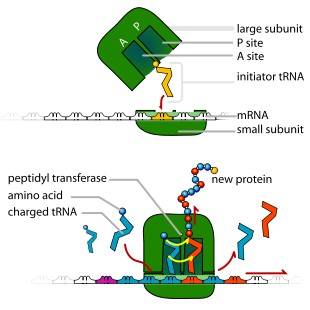Chain Termination
Chain Termination Assignment Help | Chain Termination Homework Help
Chain Termination
1. Recognition of the termination singal.
Elongation of the polypeptide chain continues until a termination codon on mRNA is reached. The termination codon may be UAA, UAG. These codons have been called ‘nonsense codon’ because ordinarily no tRNA anticodons pair with them. The termination codon need not be the last codon on mRNA. Polygenic mRNAs, which are common in bacteria and bacteriophages, have a number of initiation and termination codons directs the synthesis of a separate polypeptide chains.As the polypeptide chain is being synthesized it undergoes folding, and secondary bonds are formed between the folded regions. Thus the tertiary structure of the proteins may be attained and the final definitive shape reached even before the terminal amino acids have been added.
If a mutation results in a nonsense codon in the middle of an mRNA strand, then the polypeptide chain may be terminated prematurely at this codon. In such a condition only fragments of the polypeptide chain are formed.
2. Release of the polypeptide chain.
Even after termination the polypeptide chain remains bound to the tRNA molecule. The termination codon provides signals to the ribsosomes of attachment of release factors. The release factors interact with peptidyl transferase causing hydrolysis of the polypeptide chain at the P site. This results in cleavage and release of the chain from the tRNA molecule at the P site. The residual tRNA is now discharged from the P site. If no further cistrons are to be translated, the ribosome dissociateds into its 30S and 50S subunits. In prokaryotes there is no absolute requirement of GTP for release of the polypeptide chain.3. Processing of the polypeptide chain.
It has been seen that the starting amino acid in a polypeptide chain is either N-formylmethionine (prokaryotes) or methionine (eukaryotes). Many microorganism, however, synthesize enzymes which catalyse cleavage of the formyl residue by a deformylase or of methionine by an amino peptidase from the polypeptide chain.(1) Formyl methhionyl peptide→Formic acid + Methinyl peptide
(2) Methionyl peptide→Methionine+ peptide.
Thus the chain now begins with some other amino acid, particularly alanine, serine or threonine. Internal cleavages may also take place, e.g. the two cuts which break up the single proinsulin chain into the two pieces which constitute insulin. These two pieces are held together by S-S bonds.
In eukaryotes the polypeptide chain passes through a tunnel between the two ribosomal subunits into the cavity of the endoplasmic reticulum cisternae.

For more help in Chain Termination please click the button below to submit your homework assignment.